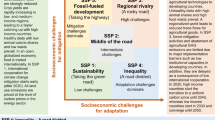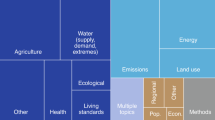Abstract
A suggestion for mapping the SRES illustrative scenarios onto the new scenarios framework of representative concentration pathways (RCPs) and shared socio-economic pathways (SSPs) is presented. The mapping first compares storylines describing future socio-economic developments for SRES and SSPs. Next, it compares projected atmospheric composition, radiative forcing and climate characteristics for SRES and RCPs. Finally, it uses the new scenarios matrix architecture to match SRES scenarios to combinations of RCPs and SSPs, resulting in four suggestions of suitable combinations, mapping: (i) an A2 world onto RCP 8.5 and SSP3, (ii) a B2 (or A1B) world onto RCP 6.0 and SSP2, (iii) a B1 world onto RCP 4.5 and SSP1, and (iv) an A1FI world onto RCP 8.5 and SSP5. A few other variants are also explored. These mappings, though approximate, may assist analysts in reconciling earlier scenarios with the new scenario framework.



Similar content being viewed by others
Notes
One of a set of six IS92 scenarios published prior to SRES by the IPCC (Leggett et al. 1992).
CMIP-3 results are available from the original data host site at the Lawrence Livermore Laboratory (PCMDI – http://www-pcmdi.llnl.gov/ipcc/about_ipcc.php) as well as from the IPCC Data Distribution Centre (DDC – http://www.ipcc-data.org/). Derivative information is also available for users from many national and international portals.
References
Ainsworth EA, Yendrek CR, Sitch S et al (2012) The effects of tropospheric ozone on net primary production and implications for climate change. Annu Rev Plant Physiol Plant Mol Biol 63:637–661
Arnell N, Lowe J, Brown S et al (2013) A global assessment of the effects of climate policy on the impacts of climate change. Nat Clim Chang 3:512–519
Carter TR, La Rovere EL, Jones RN, Leemans R, Mearns LO, Nakicenovic N, Pittock AB, Semenov SM, Skea J (2001) Developing and applying scenarios. In: McCarthy JJ, Canziani OF, Leary NA, Docken DJ, White KS (eds) Climate change 2001: Impacts, adaptation, and vulnerability. Contribution of working group II to the third assessment report of the intergovernmental panel on climate change. Cambridge University Press, Cambridge and New York, pp 145–190
Carter TR, Jones RN, Lu X, Bhadwal S, Conde C, Mearns LO, O’Neill BC, Rounsevell MDA, Zurek MB (2007) New assessment methods and the characterisation of future conditions. In: Parry ML, Canziani OF, Palutikof JP, van der Linden PJ, Hanson CE (eds) Climate change 2007: Impacts, adaptation and vulnerability. Contribution of working group II to the fourth assessment report of the intergovernmental panel on climate change. Cambridge University Press, Cambridge, pp 133–171
Ciscar J-C, Iglesias A, Feyen L et al (2011) Physical and economic consequences of climate change in Europe. Proc Natl Acad Sci 108:2678–2683
Cubasch U, Meehl GA, Boer GJ et al (eds.) Climate change 2001: the scientific basis. Contribution of Working Group I to the Third Assessment Report of the Intergovernmental Panel on Climate Change. Cambridge University Press, Cambridge and New York, pp. 525–582
De Vries W, Solberg S, Dobbertin M et al (2009) The impact of nitrogen deposition on carbon sequestration by European forests and heathlands. For Ecol Manag 258:1814–1823
Fisher B, Nakićenović N, Alfsen K et al (2007) Issues related to mitigation in the long-term context. in Metz B, Davidson O, Meyer L (eds.) Climate change 2007: mitigation of climate change. Working Group III Contribution to the IPCC Fourth Assessment Report
Hanasaki N, Fujimori S, Yamamoto T et al (2013) A global water scarcity assessment under shared socio-economic pathways - part 1: water use. Hydrol Earth Syst Sci 17:2375–2391
Hurtt GC, Chini LP, Frolking S et al (2011) Harmonization of land-use scenarios for the period 1500–2100: 600 years of global gridded annual land-use transitions, wood harvest, and resulting secondary lands. Clim Chang 109:117–161
IMAGE-team (2001) The IMAGE 2.2 implementation of the IPCC SRES scenarios. A comprehensive analysis of emissions, climate change and impacts in the 21st century. National Institute for Public Health and the Environment, Bilthoven
IPCC (2000) Special report on emissions scenarios: a special report of working group III of the intergovernmental panel on climate change. Cambridge University Press, Cambridge, p 600
IPCC (2001) Appendix II: SRES tables. In Houghton JT, Ding Y, Griggs DJ, Noguer M, van der Linden PJ, Dai X, Maskell K, Johnson CA (eds.) Climate Change 2001: The Scientific Basis. Contribution of Working Group I to the Third Assessment Report of the IPCC University Press, Cambridge and New York, pp. 799–826
Johns TC, Royer J-F, Höschel I et al (2011) Climate change under aggressive mitigation: the ENSEMBLES multi-model experiment. Clim Dyn 37:1975–2003
Klimont Z, Smith SJ, Cofala J (2013) The last decade of global anthropogenic sulfur dioxide: 2000–2011 emissions. Environ Res Lett 8:014003. doi:10.1088/1748-9326/8/1/014003
Kriegler E, O’Neill BC, Hallegatte S et al (2012) The need for and use of socio-economic scenarios for climate change analysis: a new approach based on shared socio-economic pathways. Glob Environ Chang 22:807–822
Kriegler E, Edmonds J, Hallegatte S et al (2013) A new scenario framework for climate change research: the concept of shared policy assumptions. Clim Chang
Lamarque J-F, Page Kyle G, Meinshausen M et al (2011) Global and regional evolution of short-lived radiatively-active gases and aerosols in the representative concentration pathways. Clim Chang 109:191–212
Leggett J, Pepper WJ, Swart RJ et al (1992) Emissions scenarios for the IPCC: an update. Climate change 1992: the supplementary report to the IPCC scientific assessment. Cambridge University Press, Cambridge, pp 68–95
Lowe JA, Hewitt CD, van Vuuren DP et al (2009) New study for climate modeling, analyses, and scenarios. Eos 90:181–182
Lung T, Lavalle C, Hiederer R et al (2013) A multi-hazard regional level impact assessment for Europe combining indicators of climatic and non-climatic change. Glob Environ Chang 23:522–536
Meehl GA, Covey C, McAvaney B et al (2005) Overview of the coupled model intercomparison project. Bull Am Meteorol Soc 86:89–93
Meinshausen M, Raper SCB, Wigley TML (2011a) Emulating coupled atmosphere–ocean and carbon cycle models with a simpler model, MAGICC6 - part 1: model description and calibration. Atmos Chem Phys 11:1417–1456
Meinshausen M, Smith SJ, Calvin K et al (2011b) The RCP greenhouse gas concentrations and their extensions from 1765 to 2300. Clim Chang 109:213–241
Morita T, Robinson J, Adegbulugbe A et al (2001) Climate change 2001: mitigation. Contribution of Working Group III to the Third Assessment Report of the IPCC. Cambridge University Press, Cambridge, pp 115–166
Moss RH, Edmonds JA, Hibbard K et al (2010) The next generation of scenarios for climate change research and assessment. Nature 463:747–756
O’Neill BC, Kriegler E, Riahi K et al (2013) A new scenario framework for climate change research: the concept of shared socio-economic Pathways.. Clim Chang
Pardaens AK, Lowe JA, Brown S et al (2011) Sea-level rise and impacts projections under a future scenario with large greenhouse gas emission reductions. Geophys Res Lett 38
Pitman A, de Noblet-Ducoudré N, Avila F et al (2012) Effects of land cover change on temperature and rainfall extremes in multi-model ensemble simulations. Earth Syst Dyn 13:213–231
Portmann F, Döll P, Eisner S, Flörke M (2013) Impact of climate change on renewable groundwater resources: assessing the benefits of avoided greenhouse gas emissions using selected CMIP5 climate projections. Environ Res Lett 8:doi:10.1088/1748-9326/1088/1082/024023
Rounsevell MDA, Metzger MJ (2010) Developing qualitative scenario storylines for environmental change assessment. WIREs Clim Chang 1:606–619
Schaeffer M (2013) Data on RCP and SRES model runs using MAGICC6 model
Sitch S, Brovkin V, von Bloh W et al (2005) Impacts of future land cover changes on atmospheric CO2 and climate. Glob Biogeochem Cycles 19:1–15
Taylor KE, Stouffer RJ, Meehl GA (2012) A summary of the CMIP5 experiment design. Bull Am Meteorol Soc 93:485–498
Tubiello F, Fischer G (2007) Reducing climate change impacts on agriculture: global and regional effects of mitigation. Technol Forecast Soc Chang 74:1030–1056
Van Vuuren DP, Smith SJ, Riahi K (2010) Downscaling socioeconomic and emissions scenarios for global environmental change research: a review. WIREs Clim Chang 1:393–404
Van Vuuren DP, Edmonds J, Thomson A et al (2011) Representative concentration pathways: an overview. Clim Chang 109:5–31
Van Vuuren DP, Kok MTJ, Girod B et al (2012a) Scenarios in global environmental assessments: key characteristics and lessons for future use. Glob Environ Chang 22:884–895
Van Vuuren DP, Riahi K, Moss R et al (2012b) A proposal for a new scenario framework to support research and assessment in different climate research communities. Glob Environ Chang 22:21–35
Van Vuuren DP, Kriegler E, O’Neill BC et al (2013) A new scenario framework for climate change research: scenario matrix architecture. Clim Chang. doi:10.1007/s10584-013-0906-1
Watkiss P (ed) (2011) The ClimateCost Project. Final report. Volume 1: Europe. Stockholm Environment Institute, Stockholm
Wigley TML, Raper SCB (2001) Interpretation of high projections for global-mean warming. Science 293:451–454
Acknowledgment
The authors are grateful to Dr Michael Prather for helpful advice on comparing SRES and RCP representations of atmospheric composition and radiative forcing, Dr. Michiel Schaeffer for providing MAGICC-6 model output, and to three anonymous reviewers for their most insightful and constructive comments.
Author information
Authors and Affiliations
Corresponding author
Additional information
This article is part of the Special Issue on “A Framework for the Development of New Socio-economic Scenarios for Climate Change Research” edited by Nebojsa Nakicenovic, Robert Lempert, and Anthony Janetos.
Rights and permissions
About this article
Cite this article
van Vuuren, D.P., Carter, T.R. Climate and socio-economic scenarios for climate change research and assessment: reconciling the new with the old. Climatic Change 122, 415–429 (2014). https://doi.org/10.1007/s10584-013-0974-2
Received:
Accepted:
Published:
Issue Date:
DOI: https://doi.org/10.1007/s10584-013-0974-2




